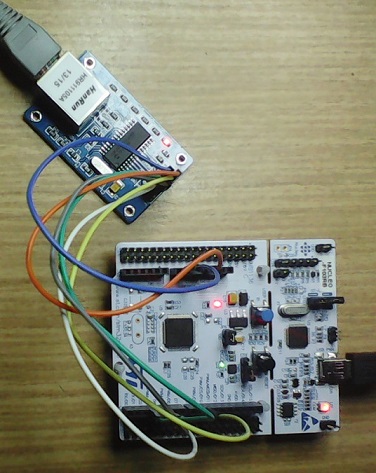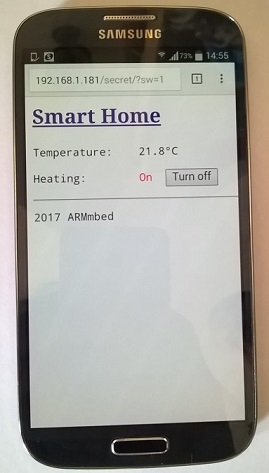HTTP Server serving a simple webpage which enables to remotely turn a digital output on/off. Compile, download, run and type 'IP_address/secret/' (don't forget the last '/') into your web browser and hit ENTER.
Turn LED1, or other digital output, on/off using a web browser.
In this example we create a HTTP server that will serve a simple Web page to remotely turn LED1, or other digital output on the mbed board, on/off by using a web browser. An inexpensive ENC28J60 Ethernet module is used to assure connection between the mbed board and the Ethernet network (Internet). The ENC28J60 Ethernet module is driven by the UIPEthernet library.
Needed parts:
- mbed board
- ENC28J60 Ethernet module
- Wires
- Web browser (Internet Explorer, Safari, Firefox, Chrome ...) running on Windows, Mac, Linux, iPhone or Android device.
 |  |
Notice that DHCP is turned on by default. If you prefer to use static IP address then uncomment line 234
The IP address assigned to the WebSwitch server along with an instruction how to use it is printed in the connected PC's serial terminal window during program start up.
Warning
Please notice that the 3.3V power supply chip (RT8183-B) installed on an STM32F103C8T6 board is not rated to power also the ENC28J60 board.
The project was inspired by the Tuxgraphics Web Switch. Thank you Guido!
NOTE:
- For a Web Switch using a WIZ550io or W5500 Ethernet module see WebSwitch_Wiz550io.
- For a Web Switch using mbed's built in Ethernet PHY see WebSwitch_mbed-dev or WebSwitch_mbed-os .
main.cpp
- Committer:
- hudakz
- Date:
- 2017-05-01
- Revision:
- 7:f5e11393836d
- Parent:
- 6:b38a3b476a45
- Child:
- 8:3bd85b731cca
File content as of revision 7:f5e11393836d:
/*
* In this project LED1 on the mbed board is switched on/off using a web browser.
* However, you can easily modify the project to remotely switch on/off any external device.
* The HTTP server is built from an mbed board and an ENC28J60 board.
* ENC28J60 is driven by the UIPEthernet library <https://github.com/ntruchsess/arduino_uip>.
* The example is based on the Tuxgraphics Web Switch <http://www.tuxgraphics.org/>.
*/
//#define TARGET_STM32F103C8T6 1 // uncomment this line when using STM32F103C8T6 boards!
#if defined(TARGET_STM32F103C8T6)
#include "stm32f103c8t6.h"
#define LED_PIN PC_13
const int OFF = 1;
const int ON = 0;
#else
#define LED_PIN LED1
const int OFF = 0;
const int ON = 1;
#endif
#include "mbed.h"
#include "UIPEthernet.h"
#include "UIPServer.h"
#include "UIPClient.h"
#include "string"
using namespace std;
Serial pc(USBTX, USBRX);
#define DHCP 1 // if you'd like to use static IP address comment out this line
// UIPEthernet is the name of a global instance of UIPEthernetClass.
// Do not change the name! It is used within the UIPEthernet library.
#if defined(TARGET_LPC1768)
UIPEthernetClass UIPEthernet(p11, p12, p13, p8); // mosi, miso, sck, cs
#elif defined(TARGET_LPC1114)
UIPEthernetClass UIPEthernet(dp2, dp1, dp6, dp25); // mosi, miso, sck, cs
#elif defined(TARGET_LPC11U68)
UIPEthernetClass UIPEthernet(P0_9, P0_8, P1_29, P0_2); // mosi, miso, sck, cs
#elif defined(TARGET_NUCLEO_F103RB) || defined(TARGET_NUCLEO_L152RE) || defined(TARGET_NUCLEO_F030R8) \
|| defined(TARGET_NUCLEO_F401RE) || defined(TARGET_NUCLEO_F302R8) || defined(TARGET_NUCLEO_L053R8) \
|| defined(TARGET_NUCLEO_F411RE) || defined(TARGET_NUCLEO_F334R8) || defined(TARGET_NUCLEO_F072RB) \
|| defined(TARGET_NUCLEO_F091RC) || defined(TARGET_NUCLEO_F303RE) || defined(TARGET_NUCLEO_F070RB)
//UIPEthernetClass UIPEthernet(D4, D5, D3, D2); // mosi, miso, sck, cs
//UIPEthernetClass UIPEthernet(D11, D12, D13, D10); // mosi, miso, sck, cs
UIPEthernetClass UIPEthernet(PA_7, PA_6, PA_5, PB_6); // mosi, miso, sck, cs
// If your board/plaform is not present yet then uncomment
// the following two lines and replace TARGET_YOUR_BOARD as appropriate.
//#elif defined(TARGET_YOUR_BOARD)
//UIPEthernetClass UIPEthernet(SPI_MOSI, SPI_MISO, SPI_SCK, SPI_CS); // mosi, miso, sck, cs
#endif
// Note:
// If it happends that any of the SPI_MOSI, SPI_MISO, SPI_SCK, SPI_CS pins collide with LED1 pin
// then either use different SPI port (if available on the board) and change the pin names
// in the constructor UIPEthernet(...) accordingly or instead of using LED1 pin, select
// a free pin (not used by SPI port) and connect to it an external LED which is connected
// to a 220 Ohm resitor that is connected to the groud.
// In the second case remember to replace LED1 in sw(LED1) constructor (see below).
// MAC number must be unique within the connected network. Modify as appropriate.
const uint8_t MY_MAC[6] = { 0x00, 0x01, 0x02, 0x03, 0x04, 0x06 };
const uint16_t MY_PORT = 80; // for HTTP connection
EthernetServer myServer = EthernetServer(MY_PORT);
// In this example we are turning on/off LED1.
DigitalOut sw(LED_PIN); // Change LED_PIN to a pin of your choice.
//DigitalOut sw(D9); // Change LED_PIN to a pin of your choice.
float roomTemp = 21.8; // A temperature sensor output
// However, make sure that it does not collide with any of the SPI pins
// already used in the UIPEthernet(...) constructor above!
const string PASSWORD = "secret"; // change as you like
const string HTTP_OK = "HTTP/1.0 200 OK";
const string MOVED_PERM = "HTTP/1.0 301 Moved Permanently\r\nLocation: ";
const string UNAUTHORIZED = "HTTP/1.0 401 Unauthorized";
string httpHeader; // HTTP header
string httpContent; // HTTP content
/**
* @brief Analyses the received URL
* @note The string passed to this function will look like this:
* GET /password HTTP/1.....
* GET /password/ HTTP/1.....
* GET /password/?sw=1 HTTP/1.....
* GET /password/?sw=0 HTTP/1.....
* @param url URL string
* @retval -1 invalid password
* -2 no command given but password valid
* -3 just refresh page
* 0 switch off
* 1 switch on
*/
int8_t analyseURL(string& url) {
if(url.substr(5, PASSWORD.size()) != PASSWORD)
return(-1);
uint8_t pos = 5 + PASSWORD.size();
if(url.substr(pos, 1) == " ")
return(-2);
if(url.substr(pos++, 1) != "/")
return(-1);
string cmd(url.substr(pos, 5));
if(cmd == "?sw=0")
return(OFF);
if(cmd == "?sw=1")
return(ON);
return(-3);
}
/**
* @brief
* @note
* @param
* @retval
*/
string& movedPermanently(uint8_t flag)
{
if(flag == 1)
httpContent = "/" + PASSWORD + "/";
else
httpContent = "";
httpContent += "<h1>301 Moved Permanently</h1>\r\n";
return(httpContent);
}
/**
* @brief
* @note
* @param
* @retval
*/
string& showWebPage(uint8_t status) {
char roomTempStr[5];
//roomTemp = ds1820.read();
sprintf(roomTempStr, "%3.1f", roomTemp);
httpContent = "<h2><a href=\".\" title=\"Click to refresh the page\">Smart Home</a></h2>";
httpContent += "<pre>Temperature:\t" + string(roomTempStr) + "°C\r\n</pre>";
if(status == ON) {
httpContent += "<pre>\r\nHeating:\t<font color=#FF0000>On </font>";
httpContent += " <a href=\"./?sw=0\"><button>Turn off</button></a>\r\n";
}
else {
httpContent += "<pre>\r\nHeating:\t<font color=#999999>Off</font>";
httpContent += " <a href=\"./?sw=1\"><button>Turn on</button></a>\r\n";
}
httpContent += "</pre>\r\n";
httpContent += "<hr>\r\n";
httpContent += "<pre>2017 ARMmbed</pre>";
return httpContent;
}
/**
* @brief
* @note
* @param
* @retval
*/
void sendHTTP(EthernetClient& client, string& header, string& content)
{
char content_length[5] = { };
header += "\r\nContent-Type: text/html\r\n";
header += "Content-Length: ";
sprintf(content_length, "%d", content.length());
header += string(content_length) + "\r\n";
header += "Pragma: no-cache\r\n";
header += "Connection: About to close\r\n";
header += "\r\n";
string webpage = header + content;
client.write((uint8_t*)webpage.c_str(), webpage.length());
}
/**
* @brief
* @note
* @param
* @retval
*/
int main(void)
{
#if defined(TARGET_STM32F103C8T6)
confSysClock(); //Configure system clock (72MHz HSE clock, 48MHz USB clock)
#endif
#if defined(DHCP)
pc.printf("Searching for DHCP server..\r\n");
if(UIPEthernet.begin(MY_MAC) != 1) {
pc.printf("No DHCP server found.\r\n");
pc.printf("Exiting application.\r\n");
return 0;
}
pc.printf("DHCP server found.\r\n");
#else
// IP address must be unique and compatible with your network.
const IPAddress MY_IP(192, 168, 1, 181); // Change as appropriate.
UIPEthernet.begin(MY_MAC, MY_IP);
#endif
IPAddress localIP = UIPEthernet.localIP();
pc.printf("Type ");
for(uint8_t i = 0; i < 3; i++)
pc.printf("%d.", localIP[i]);
pc.printf("%d/secret/ into your web browser and hit ENTER\r\n", localIP[3]);
myServer.begin();
while(1) {
EthernetClient client = myServer.available();
if(client) {
size_t size = client.available();
if(size > 0) {
uint8_t* buf = (uint8_t*)malloc(size);
size = client.read(buf, size);
string received((char*)buf);
free(buf);
if(received.substr(0, 3) != "GET") {
httpHeader = HTTP_OK;
httpContent = "<h1>200 OK</h1>";
sendHTTP(client, httpHeader, httpContent);
continue;
}
if(received.substr(0, 6) == "GET / ") {
httpHeader = HTTP_OK;
httpContent = "<p>Usage: http://host_or_ip/password</p>\r\n";
sendHTTP(client, httpHeader, httpContent);
continue;
}
int cmd = analyseURL(received);
if(cmd == -2) {
// redirect to the right base url
httpHeader = MOVED_PERM;
sendHTTP(client, httpHeader, movedPermanently(1));
continue;
}
if(cmd == -1) {
httpHeader = UNAUTHORIZED;
httpContent = "<h1>401 Unauthorized</h1>";
sendHTTP(client, httpHeader, httpContent);
continue;
}
if(cmd == ON) {
sw = ON; // turn the switch on
}
if(cmd == OFF) {
sw = OFF; // turn the switch off
}
httpHeader = HTTP_OK;
sendHTTP(client, httpHeader, showWebPage(sw));
}
}
}
}